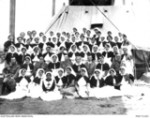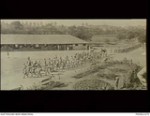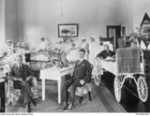GALLIN, Alice Matilda
Introduction: three Gallin sisters AANS
Alice Matilda Gallin was the first (and youngest) of three Gallin sisters to enlist in the Australian Army Nursing Service in the Great War. Her enrolment in 1915 preceded Eleanor’s by just weeks. Their eldest sister Mary Josephine joined in October 1917, soon after Alice’s brief return to Australia on troop transport duty which presumably inspired her decision.
The three sisters never served simultaneously in the same area or continent, but two worked in the same hospital on several occasions – Alice and Eleanor in Cairo, and Eleanor and Mary with 2 AGH in France in 1918 and early 1919.
Although brought up in country Victoria, the Gallin sisters had a strong connection with East Melbourne, notably through Elmore, the trained nurses home at 1101 Hoddle St operated for some years by another Gallin sister, Annie (Mrs Kelly).
Before the War
Alice Matilda Gallin (1875–1966) was the fifth of seven daughters born to Patrick Gallin (c1832–87) and his wife Mary (nee Murray or Murry, c1827–1913). The couple also had one son, John. Patrick was an Irishman from Co. Armagh who had probably arrived in the colony of Victoria not long before he married Mary. Her origins are uncertain (Irish?), but various entries by that name on shipping lists suggest she too may have not been long in the colony before her marriage.
Birth registrations put the couple as living the Sunbury/Keilor area north of Melbourne in the 1860s and until the mid 1870s. By 1878, the family was in Marong near Bendigo. This small agricultural and mining community of 134 (1881 census) had an established state school, a Roman Catholic church and a railway station – all facilities important to the Gallins. Both Patrick and Mary Gallin worked for the Victorian Railways, from 1884 at least, Patrick as a line repairer and Mary as a gatekeeper.
Patrick Gallin died in a workplace accident in 1887. Walking back to retrieve his tools, he fell in the darkness and was lying critically injured when his wife found him. ‘He blamed no one for the accident, and there could be no blame attachable to the Railway Commissioners’ (Bendigo Advertiser, 2.5.1887, p3).
Gallin left his widow and eight children ranging in age from 24 to about 9. Son John was a railway porter. Two daughters (Catherine b1871) and Margaret (b1862) married, the latter at St Patrick’s Cathedral, Melbourne with a notice in the paper. The marriage seems to have been annulled (i.e. deemed not to happen) as by 1903 Margaret had resumed the name ‘Gallin’ and her occupation as a nurse.
Margaret was the first of five of the Gallin sisters to train as a nurse. She completed her two year certificate at the Melbourne Hospital in 1883, her registration with the Victorian Trained Nurses Association in 1902. Mary, Eleanor, Alice and Annie followed.
Margaret seems to have been apart from the family, perhaps because of her marital status.
The other sisters who were nurses had a strong East Melbourne connection. Annie Kelly (nee Gallin) operated Elmore, the trained nurses home and hospital located at 1101 Hoddle St (corner of George St) from 1904 until her death in 1913. (The 10 room residence with garden had been let in 1890 (Argus, 8.1.1890, p1) and appears to have become a hospital from that time on. The electoral rolls show variously Mrs Kelly, her husband Francis, and sister Mary living at Elmore or just doors away.
Mrs Mary Gallin, their mother, died at the hospital in 1905. In her will (which she signed with a mark ‘by reason of her illiterateness’), she left her small estate (under £100) to her three spinster daughters who all resided at 1101 Hoddle St: Elenor [sic] Bridget, Alice Matilda and Agnes Cecilia (a tailoress who died in 1912).
In June 1913, Annie Kelly herself died aged 52. Mary continued to run Elmore until 1917 when the business was sold (UNA, Vol XI (11), 30.1.1914, p289, XV (9), 30.11.1917). With their parents and two sisters dead, another sister (Catherine) married and Margaret apparently estranged, Alice, Eleanor and Mary had a profession and independence.
They enlisted in the Australian Army Nursing Service, first Alice and then Eleanor in 1915, and then in 1917 Mary (who had to adjust her age to meet requirements).
War Service
Alice left Australia on RMS Mooltan on 18 May 1915. She was part of special reinforcements for No 1 Australian General Hospital at Heliopolis, made up of medical officers, nurses and other personnel, sent to deal with the unexpected and shocking casualties from the Gallipoli campaign. Her sister Eleanor arrived several months later, and worked in both 1AGH and No 2 Australian General Hospital.
1AGH was set up in the Heliopolis Palace Hotel, a four story luxury facility in the Cairo suburb of Abbassia. The Gallin sisters worked in an atmosphere of near continuous high drama. The deluge of casualties evacuated from the Gallipoli peninsula placed enormous physical and emotional demands on the nursing staff which was expanded with reinforcements as the number of beds expanded (see Rees, The Other ANZACS, pp. 44-45, 48-49). In addition, there was the battle for authority between Principal Matron Bell and 1AGH Commanding Officer Colonel Ramsay Smith that led to the recall of both to Australia in July 1915, a formal inquiry and termination of their appointments (Jan Bassett, Guns and Brooches: Australian Army Nursing from the Boer War to the Gulf War, 1992, pp. 34-39).
By early 1916, the Dardanelles campaign had ended and the fighting focus had shifted to the Western Front in Northern France and Belgium. 1AGH followed, but the Gallin sisters went in different directions. Eleanor was sent to India, and Alice to Rouen in northern France with 1AGH.
The unit’s war diary for April showed the units arriving in Marseilles and the 115 nurses being billeted there for several days pending instructions about their distribution to hospitals in the area. Alice Gallin was among the 50 sent to British hospitals, and one of 20 sent to Boulogne near the coast.
Her first hospital in France was 13 Stationary Hospital, a hutted hospital on the road to Wimereux. Olive Haynes AANS who was there shortly after Alice described it as a surgical hospital – ‘we get all the worst wounds – so you can imagine the work there is’. A French sculptor, she continued, ‘makes new jaws and noses and faces and the men will hardly be disfigured at all’ (throughtheselines.com.au/research/olive-haynes).
After two months, Alice was transferred to 1 Australian Casualty Clearing Station, 100 kms east in Estaires, which was staffed largely by 1AGH nurses. The unit war diary has little information beyond statistics of admissions, discharges and deaths, but they show that during Gallin’s seven months there …
In February 1917, Alice Gallin developed anaemia. She was sufficiently ill to be transferred to a large British hospital in Rouen and then to hospital in England. She returned to France but in April was back in England and hospitalised again, this time with weight loss, respiratory issues and then measles. It was June before she was well again. During this time, she was promoted to Sister (18 May 1917).
By this point, she had been overseas for nearly two years, nursing in hospitals where some of the most challenging casualties came.
Alice returned to Australia on nursing duty accompanying wounded troops, many of whom were amputees, on the Runic in July 1917. She was in Australia for around four months – during which time her sister Mary decided to enlist herself.
In December 1917, Alice arrived in India as part of the Indian Nursing Service. Not officially a war front, India was deemed an easier posting to the chagrin of many nurses there who wanted to serve closer to the lines. Like her sister Eleanor who served in India in 1917 after her illness in Egypt, Alice was sent to a hospital on the Deccan region, the Deccan War Hospital, where she remained throughout 1918 and early 1919.
There were around 30 Australian nurses at the Deccan War Hospital; the doctors and orderlies were English. The climate (summer, monsoon and winter) was not extreme. The patients were casualties from the fighting between the British and Turks in Mesopotamia (Iraq) brought by convoy to India.
Florence Grylls from Bendigo nursed at the hospital in mid 1917, and described conditions there (Bendigonian, 1.11.1917, p5):
We all have to use mosquito nets, and never sleep without them. Poona is considered a good summer climate. The Governor is in residence in the town, three miles from here … We have a galvanized iron room, with wide tiled roof and verandah, back and front. There is rush matting on the floor, as the snakes can’t crawl on it … There is tennis, golf and boating in Poona, three miles away.
Photographs of the hospital (Australasian, 2.6.1917) show a substantial building with new tented wards increasing the hospital’s capacity to 1000 beds in mid 1917. It also showed nurses enjoying the grounds of the residence of the Governor of Bombay, which they used for recreation.
Alice’s health appears to remain good in Poona. After more than a year there, and nearly four months after the Armistice was signed, she left Bombay for Australia on 28 February 1919. She was the first of her three sisters in the AANS to arrive back in Australia.
After the War
Alice continued to nurse on her return, though she did not live with Eleanor and Mary. Like many of her AANS colleagues after the war, she continued to nurse soldiers. She was on the staff of No 11 Australian General Hospital at Caulfield from 1919 into the 1920s.
In 1927, when she, Eleanor and Mary registered with the Victorian Nurses Board, her address was 14 Powlett St, East Melbourne so presumably she was nursing locally.
Alice was not on the electoral roll in 1931, so may have been travelling. In 1936 and 1937, she was on the staff of the Anzac Hostel in the Melbourne suburb of Brighton, a two storey mansion in which around 25 severely incapacitated veterans were cared for in a more homely environment than a hospital.
She was by then in her early 60s.
Alice was the last of the three sisters to seek assistance from the Edith Cavell Trust for sick and needy nurses. She first sought help in 1935 while suffering from influenza and asthma and received £15. In 1951 she received funds again, £55 in all, after illness and because she was 'in need'. Her last application without detail came in 1956.
After Mary died in 1940, she lived with Eleanor at 79 Flinders Lane in the city. Eleanor died in 1950, and Alice moved first to Caulfield, later Ripponlea and finally St Kilda.
She died on 17 February 1966, aged 90, in the bayside suburb of Sandringham.
Alice, Eleanor and Mary Gallin featured in the East Melbourne Historical Society's 2015 exhibition 'Gone to War a Sister: East Melbourne Nurses in the Great War'. Their panel can be seen at Gallin sisters: exhibition panel 9
Janet Scarfe, Adjunct Research Associate, Monash
6 September 2014; updated 26 November 2016



